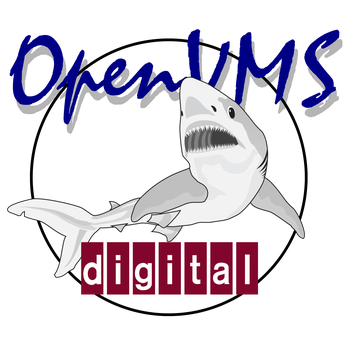Raymii.org

אֶשָּׂא עֵינַי אֶל־הֶהָרִים מֵאַיִן יָבֹא עֶזְרִֽי׃Home | About | All pages | Cluster Status | RSS Feed
Small OpenVMS titbits
Published: 22-04-2018 | Author: Remy van Elst | Text only version of this article
❗ This post is over seven years old. It may no longer be up to date. Opinions may have changed.
Table of Contents
(You can read all my OpenVMS articles by clicking the picture (above)
Here are some small titbits I found out this week on the DECUServe OpenVMS system. Not enough to write a blogpost on their own, but collected together.
.bash_history
To show your shell history from the current session:
$ RECALL/ALL
Output:
1 show proc
2 proc
3 htop
4 top
5 notes
6 t
7 hobbyist
8 hobbyi
9 show license
10 show terminal
11 set terminal /backspace=delete
12 show terminal
13 set terminal /backspace=backspace
14 show terminal
15 hello this is a test
$
Uptime and /etc/redhat_release
To view system uptime and OpenVMS version:
$ SHOW SYSTEM /NOPROC
Output:
OpenVMS V8.4-2L2 on node EISNER 8-APR-2018 14:13:11.07 Uptime 17 03:22:55
w
Show all the logged in users and their process, like the w command on linux:
$ SHOW USERS /FULL
OpenVMS User Processes at 8-APR-2018 14:19:05.07
Total number of users = 6, number of processes = 6
Username Process Name PID Terminal
<login> _VTA4425: 00009B23 VTA4425: (disconnected)
EXAMPLE SSHD 0355A PTD 00008EE4 FTA550: (ssh/$IP:57039)
GOATLEY Goat Busters 00009A55 FTA547:
(ssh/$HOSTNAME.com:17251)
JACKSON JACKSON 00005314 FTA269:
(ssh/host-$IP.static.as$AS.net:59656)
MALMBERG >>>B ewa0: 00009664 FTA543:
(ssh/$IP:59826)
SCHENKENBERG SCHENKENBERG 00007E83 FTA442:
(ssh/ool-$HOSTNAME:47078)
cd ~
Your home directory on OpenVMS is not known as ~ (as on UNIX) but as
SYS$LOGIN. As we learned in an earlier article, OpenVMS uses the SET/SHOW
DEFAULT commands to navigate directories. So the equivalent of cd ~ on linux,
or even shorter, cd is SET DEF SYS$LOGIN:
$ SET DEFAULT SYS$LOGIN
$ SHOW DEF
DISK_USER:[DECUSERVE_USER.EXAMPLE]
$ DIR SYS$LOGIN
Directory EISNER$DRA3:[DECUSERVE_USER.EXAMPLE]
$MAIN.TPU$JOURNAL;1 .VIMINFO;1 A.;1 ICREATEDAFOLDERYAY.DIR;1
LOGIN.COM;2 LOGIN.COM;1 LOGIN_COM.TPU$JOURNAL;1
MAIL$AC8D2981000500B2.MAI;1 MAIL.MAI;1 NOTES$NOTEBOOK.NOTE;1
RAYMII.DIR;1 REMY.DAT;3 REMY.DAT;2 REMY.DAT;1
SSH.DIR;1 SSH2.DIR;1 SSH3.DIR;1 WWW.DIR;1
Total of 18 files.
cd ..
The equivalent of the cd .., to go up one folder on linux, on OpenVMS is
[-]. So if you are in EISNER$DRA3:[DECUSERVE_USER.EXAMPLE.WWW] and want to
go up one level to EISNER$DRA3:[DECUSERVE_USER.EXAMPLE] then enter:
$ SET DEFAULT [-]
%SYSTEM-F-ACCVIO, access violation,
I also hit my first bug. I was writing a note (in NOTES, a kind of forum) and
I pasted a link. It crashed with the following error:
Fatal DECTPU internal error, please submit an SPR including:
1. A description of the actions that revealed the bug
2. The versions of DECTPU and the operating system you are running
3. Machine-readable media containing:
- The source files of your DECTPU section and command files
- Copies of the data files used during the session
- The keystroke journal file if one exists
4. Your terminal characteristics, if applicable
5. A description of the command used to invoke DECTPU
Shareable base: 7BC54884 Ident: DECTPU V3.2 2017-05-22 22:49
Updater base: 7C03E034 Ident: DECTPU V3.2 2017-05-22 22:49
Updater file: TPU$CCTSHR
%SYSTEM-F-ACCVIO, access violation, reason mask=00, virtual address=0000000000000024, PC=00000000000B5A14, PS=0000001B
$
So I retyped the note and pasted the error in, maybe someone knows more.
Edit: they know more on the DECUS system. This happens when you CRTL+C out of the NOTES application.
MAIL, folders and mail management
See this article as well.
List email
MAIL> dir
MAIL
# From Date Subject
1 EISNER::CORNELIUS 29-MAR-2018 Hello again
2 (Deleted)
3 EISNER::CORNELIUS 31-MAR-2018 RE: Hello again
4 EISNER::PARRIS 2-APR-2018 RE: Test message
MAIL>
List folders
MAIL> DIR /FOLDER
Listing of folders in EISNER$DRA3:[DECUSERVE_USER.EXAMPLE]MAIL.MAI
Press CTRL/C to cancel listing
MAIL TEST
MAIL>
List mail in folder
MAIL> dir TEST
TEST
# From Date Subject
1 IN%"example@example.nl" 31-MAR-2018 RE: Tesrt message
MAIL>
Regular DIR will list the MAIL folder.
Move message into a folder
To store a message in a folder, use the FILE command in the MAIL program:
MAIL> file test
Folder TEST does not exist.
Do you want to create it (Y/N, default is N)? y
%MAIL-I-NEWFOLDER, folder TEST created
MAIL>
As you can see, if the folder does not exist, it will be created.
Delete a message
OpenVMS MAIL doesn't delete messages immediately but moves them from your
default folder to a folder called WASTEBASKET.
On most OpenVMS systems the WASTEBASKET is purged when the you use the
command, EXIT to exit MAIL. If you use the command, QUIT, the old, deleted
mail remains in the WASTEBASKET. If you're in a hurry to purge the
WASTEBASKET, then you can do it manually with the PURGE command.
MAIL> dir TEST
TEST
# From Date Subject
1 IN%"example@example.nl" 31-MAR-2018 RE: Tesrt message
MAIL> del 1
MAIL> dir WASTEBASKET
WASTEBASKET
# From Date Subject
1 IN%"example@example.nl" 31-MAR-2018 RE: Tesrt message
MAIL> purge
%MAIL-I-DELMSGS, 1 message deleted
Mail filesystem folder
By default all mail related files are stored in your home directory. This can
become quite a full listing, you can change it to another folder. In the MAIL
program, enter the following command:
MAIL> SET MAIL [.MAIL]
%MAIL-I-CREATED, DISK_USER:[DECUSERVE_USER.EXAMPLE.MAIL] created
Now mail related files will be placed in [.MAIL] and your home directory will
stay a bit cleaner.
ls -la (list files, owner and permissions)
With the DIR command, two flags can be given, /PROTECTION and /OWNER, to
get a more comprehensive list including the file owner and permissions:
$ DIR /OWNER /PROTECTION
Directory DSA3:[DECUSERVE_USER.EXAMPLE]
$MAIN.TPU$JOURNAL;1
[EXAMPLE] (RWED,RWED,,)
.VIMINFO;1 [EXAMPLE] (RWED,RWED,,)
A.;1 [EXAMPLE] (RWED,RWED,,)
ICREATEDAFOLDERYAY.DIR;1
[EXAMPLE] (RWE,RWE,,)
LOGIN.COM;2 [EXAMPLE] (RWED,RWED,,)
LOGIN.COM;1 [EXAMPLE] (RWED,RWED,,)
LOGIN_COM.TPU$JOURNAL;1
[EXAMPLE] (RWED,RWED,,)
MAIL.DIR;1 [EXAMPLE] (RWE,RWE,,)
NOTES$NOTEBOOK.NOTE;1
[DECUSERVE] (RWE,RWE,,)
RAYMII.DIR;1 [EXAMPLE] (RWE,RWE,,)
REMY.DAT;3 [EXAMPLE] (RWED,RWED,,)
REMY.DAT;2 [EXAMPLE] (RWED,RWED,,)
REMY.DAT;1 [EXAMPLE] (RWED,RWED,,)
SSH.DIR;1 [EXAMPLE] (RWE,RWE,,)
SSH2.DIR;1 [EXAMPLE] (RWE,RWE,,)
SSH3.DIR;1 [EXAMPLE] (RWE,RWE,,)
WWW.DIR;1 [EXAMPLE] (RWE,RWE,,RE)
Total of 17 files.
The permission column includes in order:
- SYSTEM (root)
- OWNER (you)
- GROUP (groups you are part of)
- WORLD (everyone)
